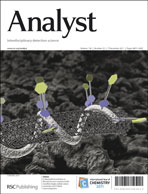A stable aqueous dispersion of poly(3,4-ethylenedioxythiophene) (PEDOT) nanorods stabilized by graphene oxide (GO) has been successfully prepared via interface polymerization of EDOT in the presence of GO for the first time. The non-covalent functionalization of PEDOT by GO leads to a PEDOT–GO dispersion that can be stable for several days without the observation of any floating or precipitated particles. Several analytical techniques including Raman spectroscopy, scanning electron microscopy (SEM), and transmission electron microscopy (TEM) have been used to characterize the resultant PEDOT–GO nanocomposites. It is found that such PEDOT–GO nanocomposites exhibit good catalytic activity toward the oxidation of nitrite, leading to a sensor for detection of nitrite. The linear detection range and detection limit are estimated to be 4 μM to 2.48 mM (r = 0.999), and 1.2 μM at a signal-to-noise ratio of 3, respectively.
You have access to this article
 Please wait while we load your content...
Something went wrong. Try again?
Please wait while we load your content...
Something went wrong. Try again?


 Please wait while we load your content...
Please wait while we load your content...